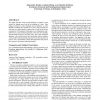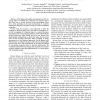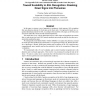216 search results - page 5 / 44 » A Hierarchical Approach to Sign Recognition |
PETRA
2009
ACM
14 years 1 months ago
2009
ACM
This paper describes work towards designing a computer vision system for helping users look up the meaning of a sign. Sign lookup is treated as a video database retrieval problem....
FGR
2008
IEEE
13 years 9 months ago
2008
IEEE
We propose several tracking adaptation approaches to recover from early tracking errors in sign language recognition by optimizing the obtained tracking paths w.r.t. to the hypoth...
ICRA
2010
IEEE
13 years 5 months ago
2010
IEEE
Abstract— Most large-scale public environments provide direction signs to facilitate the orientation for humans and to find their way to a goal location in the environment. Thus...
GW
1999
Springer
13 years 11 months ago
1999
Springer
In this paper we present a novel approach to continuous, whole-sentence ASL recognition that uses phonemes instead of whole signs as the basic units. Our approach is based on a se...
CVPR
2007
IEEE
14 years 9 months ago
2007
IEEE
One of the hard problems in automated sign language recognition is the movement epenthesis (me) problem. Movement epenthesis is the gesture movement that bridges two consecutive s...



